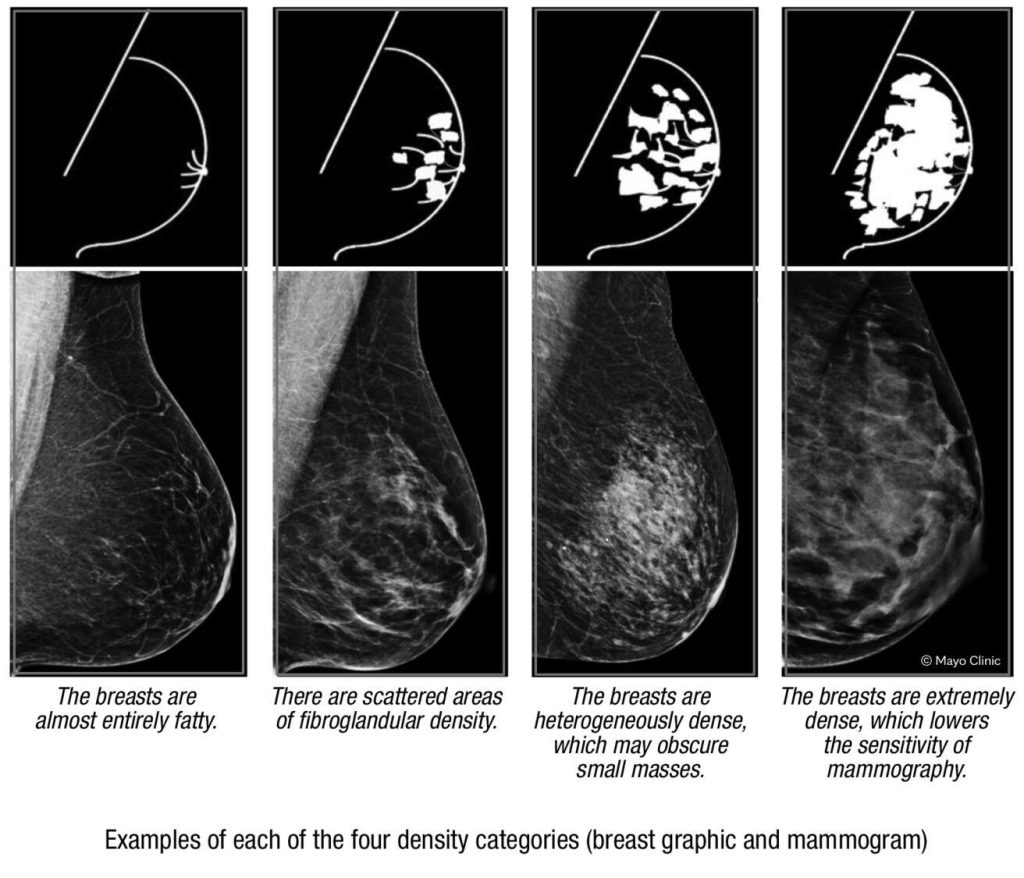-
Cancer
Mayo Clinic Q&A: What do you need to know about dense breasts?

DEAR MAYO CLINIC: I just had a mammogram, and I was told that I have dense breast tissue. What does that mean?
ANSWER: About half of women are considered to have dense breasts, based on the appearance of their breast tissue on a mammogram. The main concerns about dense breast tissue are that it makes breast cancer screening more complex and increases the risk of breast cancer. Here are some answers to questions you might have:
What is dense breast tissue?
Breast tissue is composed of milk glands, milk ducts and supportive tissue, which make up dense tissue. Breasts also include fatty tissue, which is nondense tissue. When viewed on a mammogram, women with dense breasts have more dense tissue than fatty tissue.
Nondense breast tissue typically appears dark and transparent on a mammogram. In contrast, dense breast tissue appears as a solid white area, which makes it difficult to see through.
How do doctors determine if you have dense breast tissue?
The radiologist who analyzes your mammogram determines the ratio of nondense to dense tissue and assigns a level of breast density. These levels are determined by results from the Breast Imaging Reporting and Data System from the American College of Radiology.
The levels of density are designated by letters:
- A. Breasts are almost entirely composed of fat. About 10% of women have this result.
- B. Scattered areas of density, but most breast tissue is nondense. About 40% of women have this result.
- C. Heterogeneously dense indicates some areas of nondense tissue, but most breast tissue is dense. About 40% of women have this result.
- D. Extremely dense indicates that nearly all breast tissue is dense. About 10% of women have this result.

What causes dense breast tissue?
It's not clear why some women have a lot of dense breast tissue and others don't. Dense breasts are more likely if you:
- Are younger. Your breast tissue tends to become less dense as you age, although some women may have dense breast tissue at any age.
- Have a lower body mass index. Women with less body fat are more likely to have more dense breast tissue compared with women who are obese.
- Take hormone therapy for menopause. Women who take combination hormone therapy to relieve signs and symptoms of menopause are more likely to have dense breasts.
Why does breast density matter?
Having dense breast tissue won't affect your daily life. However, it increases the chance that breast cancer may go undetected by a mammogram, since dense breast tissue can mask a potential cancer. It also increases your risk of breast cancer, though healthcare professionals aren't yet certain why.
Do screening recommendations change for dense breasts?
Women with dense breasts but no other risk factors for breast cancer are considered to have a higher risk of breast cancer than average. Dense breast tissue makes it more challenging to interpret a mammogram, since cancer and dense breast tissue both appear white on a mammogram. This may increase the risk that cancer won't be detected on a mammogram.
However, mammograms are still effective screening tools. The most common type is a digital mammogram, which is more effective at detecting cancer. It saves images of your breasts as digital files, allowing for more detailed analysis.
Are other tests more effective?
Other tests carry both risks and benefits, although MRI and molecular breast imaging have demonstrated superior cancer detection in women with dense breasts.
Supplemental tests for breast cancer screening can include:
- 3D mammogram, also known as breast tomosynthesis
Tomosynthesis uses X-rays to collect multiple images of the breast from several angles. A computer synthesizes the images to form a 3D image of the breast. Many mammogram centers are transitioning to incorporate 3D mammograms as part of the standard mammogram technology. - Breast MRI
MRI uses magnets rather than radiation to create images of the breast. This option is recommended for women with a very high risk of breast cancer, such as those with genetic mutations. - Molecular breast imaging
This imaging uses a gamma camera to record the activity of a radioactive tracer. The tracer is injected into a vein in your arm. Normal tissue and cancerous tissue react differently to the tracer, which can be seen in the images captured by the camera.
Every test has pros and cons. Talk with your healthcare professional about your breast cancer risk factors. Together, you can decide whether additional screening tests are right for you.
Cameron Leitch, M.D., Radiology, Mayo Clinic Health System, Eau Claire, Wisconsin
Related posts:
- Mayo Clinic leads 4 decades of advances in breast cancer care
- Mayo Clinic research improves dense breast cancer screening and early detection
- Top 10 questions about breast cancer answered
- Mayo Clinic treats first person in the US with a novel radiopharmaceutical therapy for breast cancer
- Mayo Clinic Minute: MRI for dense breasts — what to know
- Mayo Clinic Q&A: How to decide which breast cancer surgery is right for you
- (VIDEO) Back on the bench: Judge’s metastatic breast cancer journey inspires hope







